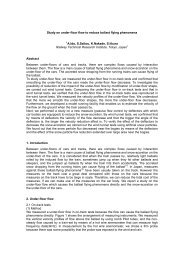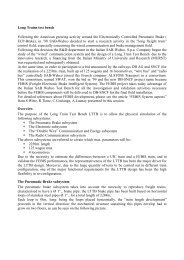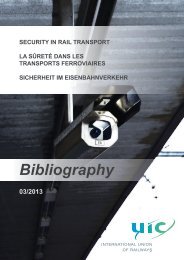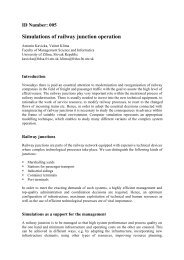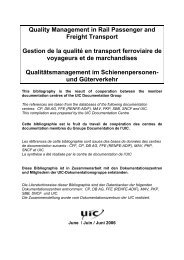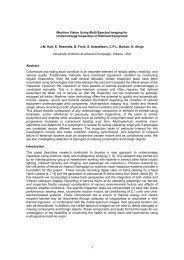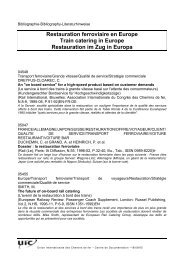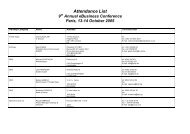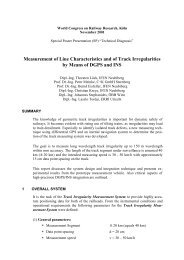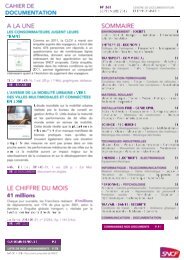Steady State and Transient Short Circuit Analysis of 2x25 kV ... - UIC
Steady State and Transient Short Circuit Analysis of 2x25 kV ... - UIC
Steady State and Transient Short Circuit Analysis of 2x25 kV ... - UIC
You also want an ePaper? Increase the reach of your titles
YUMPU automatically turns print PDFs into web optimized ePapers that Google loves.
<strong>Steady</strong> <strong>State</strong> <strong>and</strong> <strong>Transient</strong> <strong>Short</strong> <strong>Circuit</strong> <strong>Analysis</strong> <strong>of</strong> <strong>2x25</strong> <strong>kV</strong> High Speed Railways<br />
Abstract<br />
1 L. Battistelli, M. Pagano D.Proto, 2 A. Amendola, L. Cundurro, A. Pignotti<br />
Università degli Studi di Napoli Federico II, Napoli, Italy 1 ;<br />
Ansaldo Segnalamento Ferroviario,Napoli, Italy 2<br />
In the paper, a detailed model for the short circuit analysis <strong>of</strong> the AC <strong>2x25</strong> <strong>kV</strong>-50 Hz traction<br />
system has been derived <strong>and</strong> implemented. Two different methods have been used: the time<br />
domain <strong>and</strong> frequency domain approaches. The two approaches are discussed <strong>and</strong> numerical<br />
applications are reported. In particular, in order to assess the feasibility <strong>of</strong> both the two<br />
methodologies, the results have been compared in steady state condition. Then a transient<br />
analysis has been performed by means <strong>of</strong> the time domain simulator evidencing the short circuit<br />
current transient behavior.<br />
Introduction<br />
The <strong>2x25</strong> <strong>kV</strong> feeding system is considered an optimal solution for high speed railways. The<br />
reduction in the number <strong>of</strong> electric substations as well as a greater efficiency due to the use <strong>of</strong><br />
higher transmission voltages (50 <strong>kV</strong> supply between catenary <strong>and</strong> return feeder) with lower<br />
currents <strong>and</strong> lower voltage locomotive traction equipment (25 <strong>kV</strong> rail-catenary voltage) are the<br />
main advantages <strong>of</strong> the system [1]. Moreover, other advantages are related to the reduction <strong>of</strong><br />
electromagnetic interference between traction converters <strong>and</strong> adjacent telecommunications<br />
circuits as well as the reduction <strong>of</strong> voltage drops.<br />
Notwithst<strong>and</strong>ing, critical operating conditions related to short circuit events can occur interfering<br />
with the traction system components so compromising the functionality <strong>of</strong> the whole system.<br />
The short circuit levels are particularly critical also due to the presence <strong>of</strong> the autotransformers<br />
that increases the fault currents. <strong>Short</strong>-circuit analysis is important not only for determining the<br />
rating <strong>of</strong> power equipment <strong>and</strong> the setting <strong>of</strong> protection devices but also for checking the voltage<br />
pr<strong>of</strong>iles <strong>of</strong> the network <strong>and</strong> <strong>of</strong> the buses near the fault as well as the electromagnetic<br />
compatibility with adjacent circuits. Thus, a detailed short-circuit study is required in both steady<br />
state <strong>and</strong> transient condition [2-3].<br />
The accuracy <strong>of</strong> the system components is an important concern for the short circuit analysis<br />
since it significantly affects the simulation results. A critical issue, for example, is the<br />
identification <strong>of</strong> the impedances <strong>of</strong> the system components <strong>and</strong> the configuration <strong>of</strong> the network<br />
since they mainly determine the short-circuit results. Particular attention must be paid to an<br />
accurate modeling <strong>of</strong> the autotransformers as well as <strong>of</strong> both self <strong>and</strong> mutual impedances <strong>of</strong> the<br />
contact wire, rails <strong>and</strong> feeder.<br />
In this paper the <strong>2x25</strong> <strong>kV</strong> electric railway system has been modeled in order to perform detailed<br />
steady state <strong>and</strong> transient short-circuit analyses. The steady state model has been implemented<br />
by means <strong>of</strong> a sequence <strong>of</strong> impedance matrices (chain matrices) representing each component<br />
[4-5].<br />
The same system has been implemented also by using computer simulations developed in time<br />
domain by means <strong>of</strong> Matlab Power System Blockset, allowing to easily evaluate complex<br />
system behavior by representing each power system component by an equivalent block. The<br />
toolbox is suitable for efficient time-domain simulations, allowing to capture the functional<br />
dependence <strong>of</strong> system characteristics on time <strong>and</strong> various interest parameters. Through the<br />
time domain simulation, the short circuit analysis has been performed in transient condition.<br />
In the paper the description <strong>of</strong> the considered traction system <strong>and</strong> <strong>of</strong> the problem formulation as<br />
well as the description <strong>of</strong> both the two proposed methodologies has been detailed. Both steady<br />
state <strong>and</strong> transient conditions have been investigated. Some experimental results on a<br />
measurement campaign conducted on the actual Italian system validate the results obtained in<br />
the simulation procedure.
Problem Description<br />
In the <strong>2x25</strong> <strong>kV</strong> traction system the substation transformer feeds the overhead contact wire that<br />
supplies the trains as well as the feeder wire that runs along the track. The voltage <strong>of</strong> the<br />
overhead contact wire <strong>and</strong> feeder are respectively +25 <strong>kV</strong> <strong>and</strong> -25 <strong>kV</strong>. Autotransformers spaced<br />
along a section <strong>of</strong> track connect the contact wire, feeder <strong>and</strong> rails through a median tap. The<br />
electrical substations are equipped with 2 single phase transformers, each one feeding a railway<br />
line section <strong>of</strong> about 25 km. Autotransformers distanced by approximately 12 km divide the line<br />
sections in cells. In this configuration the current flows through the contact line <strong>and</strong> the feeder<br />
<strong>and</strong> there is no current in the rails except in the cell occupied by the train. The simplified<br />
scheme <strong>of</strong> the system operating condition (100 A traction load) is shown in Fig.1.<br />
- 25 <strong>kV</strong> FEEDER<br />
50A<br />
50A 50A<br />
+ 25 <strong>kV</strong> CONTACT WIRE<br />
1 st cell<br />
50A<br />
50A<br />
25A<br />
25A<br />
2 nd cell 3 rd cell<br />
25A<br />
50A<br />
Fig.1: <strong>2x25</strong> <strong>kV</strong> traction system scheme<br />
A 12 km cell contains all the basic elements constituting the <strong>2x25</strong> <strong>kV</strong> traction system:<br />
- the substation equipped with two single phase 60 MVA transformers;<br />
- the parallel post (PP) equipped with two single phase 15 MVA autotransformers;<br />
- the supply circuit containing messenger wires, contact lines, feeders <strong>and</strong> rails;<br />
- the earth circuit containing the protection <strong>and</strong> buried earth conductors.<br />
- capacitive compensators, located between the rails every 100 m;<br />
- inductive bonds, connecting the rails to the earth circuit for interference mitigation, located<br />
every 1500 m.<br />
The transversal section <strong>of</strong> Fig.2 shows 14 conductors: the double track system wires (2 contact<br />
lines, 2 feeders, 2 messenger wires, 4 rail tracks, 2 buried earth conductors, 2 overhead earth<br />
conductors).<br />
Two alternative implementations have been considered for short-circuit analysis. The former is<br />
performed by means <strong>of</strong> the frequency domain algorithm. The latter is performed by means <strong>of</strong><br />
time domain simulation.<br />
Feeder<br />
Protection<br />
wire<br />
Messenger wire<br />
Contact wire<br />
Contact wire<br />
Rails Rails<br />
Buried earth wires<br />
Messenger wire<br />
Feeder<br />
Protection<br />
wire<br />
Fig.2: Transversal section <strong>of</strong> the <strong>2x25</strong> <strong>kV</strong> railway system.<br />
To perform the analyses in the frequency domain, each element is represented by means <strong>of</strong> an<br />
equivalent impedance matrix. The system is solved by means <strong>of</strong> algebraic matrix operations.
In the time domain simulation, each component is represented by its differential equations.<br />
Finally, the system is represented by the whole set <strong>of</strong> the differential equations.<br />
In the following the system modeling for both the two approaches is briefly discussed [6].<br />
Solving Procedures<br />
Frequency domain model This algorithm starts representing the traction system by the node<br />
impedance matrix through inspection <strong>and</strong>, then, it deduces the fault current in each branch <strong>of</strong><br />
the traction network as well as the curve <strong>of</strong> fault current versus fault location. The algorithm has<br />
the following advantages:<br />
- all system components are described in exactly the same manner by defining their "primitive<br />
Z-node matrix";<br />
- some more complex cases that <strong>of</strong>ten require "approximations" in classical methods can be<br />
h<strong>and</strong>led in a clean manner without numerical difficulties.<br />
The basic idea <strong>of</strong> the frequency domain model is the representation <strong>of</strong> the whole system<br />
through a sequence <strong>of</strong> impedance matrices (chain matrices) representing each component.<br />
According to the aim <strong>of</strong> the approach, each element is represented by a chain matrix, which<br />
relates the output voltages <strong>and</strong> currents to the input values:<br />
⎡V<br />
⎢<br />
⎣I<br />
out<br />
out<br />
⎤<br />
⎥ =<br />
⎦<br />
⎡V<br />
⎤<br />
⎡A<br />
in 1 2 in<br />
[ A]<br />
⋅ ⎢ ⎥ = ⎢ ⎥ ⋅ ⎢ ⎥<br />
⎣I<br />
in ⎦ A 3 A 4 ⎣I<br />
in ⎦<br />
⎣<br />
A ⎤ ⎡V<br />
⎤<br />
⎦<br />
where Vout (Iout) is the [nx1] output voltage (current) vector, Vinp (Iinp) is the [nx1] input voltage<br />
(current) vector, <strong>and</strong> A is the [2nx2n] chain matrix. Matrix A can be divided in four submatrices<br />
<strong>of</strong> [nxn], where, in particular, A2 is the impedance matrix, <strong>and</strong> A3 is the admittance matrix.<br />
Chain matrices can be calculated as the product <strong>of</strong> the matrices <strong>of</strong> each individuated element.<br />
Aim <strong>of</strong> the model is the identification <strong>of</strong> voltage <strong>and</strong> current phasors at all the system locations.<br />
It is worth noting that the model <strong>of</strong> the system components significantly affects the level <strong>of</strong><br />
accuracy <strong>of</strong> the simulations.<br />
In the following a description <strong>of</strong> each component’s frequency domain model is detailed.<br />
Substation model. The substation model is basically constituted by the single phase<br />
transformer <strong>and</strong> the substation earth circuit. Fig.4 shows the equivalent circuit model adopted<br />
for the substation transformer.<br />
VS<br />
RT<br />
Z1<br />
Fig.4: Substation equivalent circuit<br />
Z2<br />
Z3<br />
Messanger<br />
wires<br />
Contact<br />
wires<br />
Feeders<br />
Buried <strong>and</strong><br />
overhead<br />
earth<br />
conductors<br />
For this representation 14 equivalent circuit equations <strong>and</strong> the corresponding matrix equation<br />
have been derived:<br />
[ V( 0)<br />
] [ V ] − [ Z ] ⋅[<br />
I(<br />
0)<br />
]<br />
= S<br />
s (2)<br />
The substation model is represented by a [14x1] matrix. VS assumes value <strong>of</strong> +25<strong>kV</strong> for<br />
messenger <strong>and</strong> contact wires, -25<strong>kV</strong> for feeder; ZS is derived from the equivalent circuit <strong>of</strong> the<br />
figure.<br />
Rails<br />
(1)
Parallel post model. The parallel post is constituted by the autotransformer whose equivalent<br />
circuit is shown in Fig.5. The characteristic chain matrix is:<br />
[ V( x) ] [ Zpp<br />
] ⋅[<br />
I(<br />
x)<br />
]<br />
= (3)<br />
where ZPP is derived from the equivalent circuit <strong>of</strong> Fig.5.<br />
Messanger<br />
wires<br />
Contact<br />
wires<br />
Buried <strong>and</strong><br />
overhead<br />
earth<br />
conductors<br />
Rails<br />
Feeders<br />
ZT<br />
Zm<br />
Fig.5: Parallel Post equivalent circuit<br />
Z1<br />
Z2<br />
Messanger<br />
wires<br />
Contact<br />
wires<br />
Buried <strong>and</strong><br />
overhead<br />
earth<br />
conductors<br />
Multi-conductor line model. The line section is modeled according to the method proposed in<br />
[7]. The model includes 14 conductors whose auto <strong>and</strong> mutual impedances have been<br />
considered. The governing multi transmission line (MTL) equations are a coupled set <strong>of</strong> firstorder<br />
partial differential equations:<br />
∂<br />
∂<br />
V(<br />
z,<br />
t)<br />
= RI(<br />
z,<br />
t)<br />
− L I(<br />
z,<br />
t)<br />
∂z<br />
∂z<br />
∂<br />
∂<br />
I(<br />
z,<br />
t)<br />
= GV(<br />
z,<br />
t)<br />
− C V(<br />
z,<br />
t)<br />
∂z<br />
∂z<br />
where V contains the line voltages with respect to the reference conductor; I contains the line<br />
currents; <strong>and</strong> R, L, G, <strong>and</strong> C denote the per-unit-length parameters. The parameters are<br />
calculated from the geometry <strong>of</strong> the multi-conductor line configuration <strong>and</strong> the physical<br />
characteristics <strong>of</strong> the conductors.<br />
The solution <strong>of</strong> the general phasor MTL equations for a line <strong>of</strong> length A can be written in the<br />
chain matrix form as:<br />
⎡V(<br />
A)<br />
⎤ ⎡Θ<br />
⎢ ⎥ = ⎢<br />
⎣ I(<br />
A)<br />
⎦ ⎣Θ<br />
11<br />
21<br />
( A)<br />
( A)<br />
Θ<br />
Θ<br />
12<br />
22<br />
( A)<br />
⎤ ⎡V(<br />
0)<br />
⎤<br />
⎥ ⋅<br />
( A)<br />
⎢ ⎥<br />
⎦ ⎣ I(<br />
0)<br />
⎦<br />
Signalling track circuit element model. Two main components have to be considered for an<br />
accurate modelling <strong>of</strong> the system behaviour: the capacitive compensators <strong>and</strong> the inductive<br />
bonds.<br />
a) Capacitive compensator<br />
The chain sub-matrices <strong>of</strong> the element are calculated by output-input relations derived<br />
according to the circuit <strong>of</strong> Fig.7:<br />
⎡V1C<br />
⎤ ⎡I<br />
1C ⎤ ⎡A<br />
C1 AC<br />
2 ⎤ ⎡I1C<br />
⎤<br />
⎢ ⎥ = [ A ] ⋅ ⎢ ⎥ = ⎢ ⎥ ⋅ ⎢ ⎥ (6)<br />
C<br />
⎣V2C<br />
⎦ ⎣I<br />
2C<br />
⎦ ⎣A<br />
C3<br />
AC<br />
4 ⎦ ⎣I<br />
2C<br />
⎦<br />
where [AC1]= [AC4]=[I], [AC4]=0 <strong>and</strong><br />
Rails<br />
Feeders<br />
(4)<br />
(5)
[ A ] &<br />
C3<br />
⎡0<br />
⎢<br />
⎢<br />
0<br />
⎢..<br />
⎢<br />
⎢0<br />
= ⎢..<br />
⎢<br />
⎢0<br />
⎢..<br />
⎢<br />
⎢0<br />
⎢<br />
⎣0<br />
0<br />
0<br />
..<br />
0<br />
..<br />
0<br />
..<br />
0<br />
0<br />
..<br />
..<br />
..<br />
..<br />
..<br />
..<br />
..<br />
..<br />
..<br />
0<br />
0<br />
..<br />
− jωC<br />
..<br />
jωC<br />
..<br />
0<br />
0<br />
..<br />
..<br />
..<br />
..<br />
..<br />
..<br />
..<br />
..<br />
..<br />
0<br />
0<br />
..<br />
jωC<br />
..<br />
− jωC<br />
..<br />
0<br />
0<br />
⎡V1C<br />
⎤<br />
⎢ ⎥<br />
⎣ I1C<br />
⎦<br />
..<br />
..<br />
..<br />
..<br />
..<br />
..<br />
..<br />
..<br />
..<br />
0<br />
0<br />
..<br />
0<br />
..<br />
0<br />
..<br />
0<br />
0<br />
0⎤<br />
0<br />
⎥<br />
⎥<br />
.. ⎥<br />
⎥<br />
0⎥<br />
.. ⎥<br />
⎥<br />
0⎥<br />
.. ⎥<br />
⎥<br />
0⎥<br />
0<br />
⎥<br />
⎦<br />
.<br />
.<br />
.<br />
C<br />
Fig.7: Compensator capacitor<br />
b) Inductive bond<br />
Similarly, the chain submatrices <strong>of</strong> the inductive bond are calculated by output-input relations<br />
derived according to the circuit <strong>of</strong> Fig.8.<br />
.<br />
.<br />
.<br />
L<br />
L<br />
rail<br />
rail<br />
Earth conductors<br />
⎡V2C<br />
⎤<br />
⎢ ⎥<br />
⎣ I2C<br />
⎦<br />
⎡V<br />
1i<br />
⎤<br />
⎡V<br />
2i<br />
⎤<br />
⎢ ⎥<br />
⎣ I<br />
⎢ ⎥<br />
1i<br />
⎦<br />
⎣ I 2i<br />
⎦<br />
rails<br />
rails<br />
Earth conductors<br />
Fig.8: Inductive bonds<br />
Time domain model. The time domain simulations are developed by means <strong>of</strong> Matlab Power<br />
System Blockset (PSB). Each component is represented by a block, suitable to physically<br />
represent the behaviour <strong>of</strong> the component.<br />
In the following the description <strong>of</strong> each component’s time domain model is detailed.<br />
Substation model. The substation model is a 14 output line block basically composed by a<br />
single phase three windings transformer whose secondary windings are connected to feeders,<br />
contact wires <strong>and</strong> rails, Fig.9.<br />
AC<br />
SSE 60 MVA, 50 <strong>kV</strong><br />
RT<br />
Fe 1<br />
1<br />
2<br />
Fe 2<br />
3<br />
FP 1<br />
4<br />
LDC1<br />
5<br />
FP 2<br />
6<br />
LDC 2<br />
7<br />
rot ext 1<br />
8<br />
rot int 1<br />
9<br />
rot int 2<br />
10<br />
rot ext 2<br />
11<br />
Cdt 1<br />
12<br />
Disp 1<br />
13<br />
Cdt 2<br />
14<br />
Disp 2<br />
Fig.9: PSB Substation model
Parallel post model. For the autotransformer model, a 14 I/O line block composed by a single<br />
phase three windings transformer connected as represented in Fig.10 has been used.<br />
Fig.10: PSB parallel post model<br />
Multi-conductor line model. The multi-conductor line has been implemented by the PSB<br />
Distributed Parameters Line Block, that implements a N-phase distributed parameter line model<br />
with lumped losses. The resistance R, inductance L, capacitance C line parameters are<br />
specified in [nxn] matrices.<br />
Signalling track circuit elements model. To reproduce the effects <strong>of</strong> capacitive compensators<br />
<strong>and</strong> inductive bonds, equivalent electrical lumped elements have been introduced in the model,<br />
according to the data reported in Tab.1.<br />
Capacitive compensator (rail to rail) 25e-6 F<br />
Inductive bond (rail to buried earth<br />
conductor)<br />
1.2 mH<br />
Table 1: Capacitive compensator <strong>and</strong> inductive bond values.<br />
It can be noted that the time domain model allows to perform analyses in both steady state <strong>and</strong><br />
transient conditions. The frequency domain model is an optimal tool for performing steady state<br />
analysis <strong>and</strong> is particularly suitable for harmonic studies [7,8]. It can be also used to analyze<br />
transients subject to the limitations <strong>of</strong> the superposition principle (applicable to linear systems).<br />
In the current paper the following assumptions have been made:<br />
- According to the technical literature [8,9], the electromagnetic fields have TEM structure,<br />
which corresponds to the assumption <strong>of</strong> planewave propagation along the line.<br />
- The multi conductor line representation does not take into account the inequalities in the<br />
earth’s surface <strong>and</strong> its lack <strong>of</strong> conductive homogeneity whose estimation can be found in [10]<br />
- According to [11], for short circuit analyses, the lumped compensator capacitors have been<br />
neglected.<br />
Numerical Applications<br />
In order to test the two implemented simulation methods for the short circuit analysis, several<br />
system configurations have been considered. In the following the results obtained for two<br />
system configurations: a single cell <strong>of</strong> 12 km <strong>and</strong> a 4-cell system <strong>of</strong> about 50 km.<br />
The first case implemented consists <strong>of</strong> a short circuit (between the overhead catenary <strong>and</strong> rail)<br />
located at 0.7 km far from the substation. The single cell is included between the substation <strong>and</strong><br />
the parallel post. The short circuit has been simulated with a resistance <strong>of</strong> 0.001 Ω. Tab. I<br />
shows the numerical results in steady state conditions.
Monitored RMS<br />
values<br />
[A]<br />
Distances from<br />
the substation<br />
[km]<br />
Time<br />
Domain<br />
Frequency<br />
domain<br />
If 0.7 9973 9597<br />
Icl 12 936.7 844.7<br />
Ife 12 924.1 868.3<br />
Irail 12 414.6 473.2<br />
Icl 0 9036 8753<br />
Ife 0 923.5 867.7<br />
Irail 0 6652 7518<br />
Table 2: Comparison <strong>of</strong> the results <strong>of</strong> the steady state short circuit analysis [6]<br />
Tab. 2 evidences that the two models give similar results. A slightly higher fault current can be<br />
observed in the time domain simulation.<br />
In order to test the system in transient condition a 50 km traction system has been considered.<br />
The system <strong>of</strong> 4 cells includes 1 feeding substation <strong>and</strong> 4 parallel posts. The short circuit is<br />
located at the distance <strong>of</strong> 50 km from the substation in correspondence <strong>of</strong> the fourth parallel<br />
post. The short circuit occurs at 0.5 ms between overhead <strong>and</strong> buried earth wires.<br />
Fig. 11 shows the instantaneous waveform <strong>of</strong> the peak fault current.<br />
Fig. 11: Waveform <strong>of</strong> the fault current in case <strong>of</strong> overhead-buried earth wire short circuit<br />
By the analysis <strong>of</strong> the figure it can be noted that the system is characterized by a typical first<br />
order dynamic where the peak value depends on the instantaneous system conditions when the<br />
short circuit occurs. The time constant is a function <strong>of</strong> the system parameters <strong>and</strong> for severe<br />
short circuit it very slightly depends on the short circuit resistance value. To focus on the<br />
transient in Fig. 12 the positive peak values <strong>of</strong> the fault current are reported.
Conclusions<br />
Fig. 12: Positive fault current peak values<br />
Two methodologies for short circuit current calculation in the <strong>2x25</strong> <strong>kV</strong> traction system have been<br />
proposed. The two approaches are performed in frequency <strong>and</strong> time domains. They both<br />
represent the physical components by means <strong>of</strong> respectively the chain matrix <strong>and</strong> partial<br />
differential equation mathematical models.<br />
The numerical application reported investigates on steady state <strong>and</strong> transient operating<br />
conditions. The results <strong>of</strong> the application are able to assess the suitability to perform short circuit<br />
analyses by both the two models.<br />
Future works will be aimed at validating the numerical applications with experimental results<br />
obtained through a measurement campaign.<br />
References<br />
[1] I. Senol, H. Gorgun, M.G. Aydeniz: “General comparison <strong>of</strong> the electrical transportation<br />
systems that are fed with 1×25 <strong>kV</strong> or 2×25 <strong>kV</strong> <strong>and</strong> expectations from these systems”,<br />
Electrotechnical Conference, 1998 MELECON 98, 9th Mediterranean, Vol.2, 18-20 May 1998<br />
Page(s): 885 – 887.<br />
[2] T. H. Chen, Y. F. Hsu, “Systematized short-circuit analysis <strong>of</strong> a <strong>2x25</strong> <strong>kV</strong> electric traction<br />
network”, Electric Power Systems Research, Vol. 47, 1998, pp. 133-142.<br />
[3] P.C. Coles, M. Fracchia, R.J. Hill, P. Pozzobon, A. Szelag: “Identification <strong>of</strong> catenary<br />
harmonics in 3 <strong>kV</strong> DC railway traction systems”, Proceedings <strong>of</strong> the 7th Mediterranean<br />
Electrotechnical Conference, Vol. 2, April 1994, pp. 825 -828.<br />
[4] Clayton R. Paul: “<strong>Analysis</strong> <strong>of</strong> Multiconductor Transmission Lines”, John Wiley & Sons,<br />
November 2007.<br />
[5] J. Arillaga, N.R. Watson, S. Chen: “Power System Quality Assessment”, John Wiley <strong>and</strong><br />
Sons, 2000 pp.171-228.<br />
[6] A. Amendola, L.Battistelli, L.Cundurro, M.Pagano, D.Proto: “<strong>Short</strong> <strong>Circuit</strong> Modelling <strong>and</strong><br />
Simulation <strong>of</strong> <strong>2x25</strong> <strong>kV</strong> High Speed Railways”, accepted to the 10 th International Confeence on<br />
Computer Modelling <strong>and</strong> Simulation, 1-3 April 2008.<br />
[7] R. Cella, G. Giangaspero, A. Mariscotti, A. Montepagano, P. Pozzobon, M. Ruscelli, <strong>and</strong> M.<br />
Vanti: “Measurement <strong>of</strong> AT Electric Railway System Currents at Power-Supply Frequency <strong>and</strong>
Validation <strong>of</strong> a Multiconductor Transmission-Line Model”, IEEE Transactions on Power Delivery,<br />
Vol. 21, N.3, 2006, pp. 1721-1726.<br />
[8] A. Mariscotti, P. Pozzobon: “Determination <strong>of</strong> the electrical parameters <strong>of</strong> railway traction<br />
lines: Calculation, measurement <strong>and</strong> reference data”, IEEE Trans. Power Del., vol. 19, no. 4,<br />
Oct. 2004, pp. 1538–1546.<br />
[9] R.J. Hill, D.C. Carpenter: “Rail track distributed transmission line impedance <strong>and</strong> admittance:<br />
theoretical modeling <strong>and</strong> experimental results”, IEEE Transactions on Vehicular Technology,<br />
Vol. 42, Issue 2, May 1993, pp. 225 -241.<br />
[10] J.R.Carson: “Wave propagation in overhead wires with ground return”, The Bell System<br />
Technical Journal, Vol. 5, 1926, pp. 539-544.<br />
[11] CEI EN 60909-0, “Correnti di cortocircuito nei sistemi trifasi in corrente alternata”, 2001-12.<br />
Appendix<br />
The results reported are obtained for following parameters <strong>of</strong> the traction system:<br />
Substation transformer parameters<br />
Power: 60 MVA, voltage ratio: 132/2x27.5 <strong>kV</strong>, short circuit voltage: 10%<br />
Auto-transformer Parameters<br />
Power: 15 MVA, voltage ratio: 27.5/0/-27.5 <strong>kV</strong>, short circuit voltage: 1%.<br />
Multi conductor line parameters<br />
Tab. A shows the materials, resistivity (Ω/km), sections <strong>and</strong> positions <strong>of</strong> all the conductors<br />
involved in the systems.<br />
Description Material Resistance Section<br />
[Ω/km] [mm 2 ]<br />
X<br />
[m]<br />
Y<br />
[m]<br />
Left side track system<br />
Feeder Al 0,109 307 -6,60 8,00<br />
Messanger Cu 0,15 120 -2,50 6,55<br />
Contact line Cu 0,12 150 -2,50 5,30<br />
External Rail UNI60 -3,26 0,01<br />
Internal Rail UNI60 -1,74 0,01<br />
Buried earth wire Cu 0,19 95 -5,00 -1,12<br />
Protection wire Al 0,225 150 -6,12 5,50<br />
Right side track system<br />
Feeder Al 0,109 307 6,60 8,00<br />
Messanger Cu 0,15 120 2,50 6,55<br />
Contact line Cu 0,12 150 2,50 5,30<br />
External Rail UNI60 3,26 0,01<br />
Internal Rail UNI60 1,74 0,01<br />
Buried earth wire Cu 0,19 95 5,00 -1,12<br />
Protection wire Al 0,225 150 6,12 5,50<br />
Table A: Track line parameters



